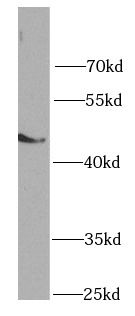Products
SHH antibody
Category:
Research Area:
| Synonyms: | HHG 1 antibody, HHG1 antibody, HLP3 antibody, HPE3 antibody, MCOPCB5 antibody, SHH antibody, SMMCI antibody, Sonic hedgehog protein antibody, TPT antibody, TPTPS antibody | ||
| Catalogue No.: | FNab07847 | Reactivity: | Human, Mouse, Rat |
| Host: | Rabbit | Tested Application: | ELISA, WB, IHC |
| Clonality: | polyclonal | Isotype: | IgG |
- SPECIFICATIONS
- Product Name
- SHH antibody
- Catalogue No.
- FNab07847
- Size
- 100μg
- Form
- liquid
- Purification
- Immunogen affinity purified
- Purity
- ≥95% as determined by SDS-PAGE
- Clonality
- polyclonal
- Isotype
- IgG
- Storage
- PBS with 0.02% sodium azide and 50% glycerol pH 7.3, -20℃ for 12 months (Avoid repeated freeze / thaw cycles.)
Immunogen
- Immunogen
- sonic hedgehog homolog (Drosophila)
- Alternative Names
- HHG 1 antibody, HHG1 antibody, HLP3 antibody, HPE3 antibody, MCOPCB5 antibody, SHH antibody, SMMCI antibody, Sonic hedgehog protein antibody, TPT antibody, TPTPS antibody
- UniProt ID
- Q15465
- Observed MW
- 47 kDa
Application
- Tested Applications
- ELISA, WB, IHC
- Recommended dilution
- WB: 1:500 - 1:2000; IHC: 1:50 - 1:100
Validated Images
 mouse liver tissue were subjected to SDS PAGE followed by western blot with FNab07847(SHH antibody) at dilution of 1:1000
mouse liver tissue were subjected to SDS PAGE followed by western blot with FNab07847(SHH antibody) at dilution of 1:1000
 Immunohistochemistry of paraffin-embedded rat kidney using FNab07847( SHH Antibody) at dilution of 1:100
Immunohistochemistry of paraffin-embedded rat kidney using FNab07847( SHH Antibody) at dilution of 1:100
- Background
- This gene encodes a protein that is instrumental in patterning the early embryo. It has been implicated as the key inductive signal in patterning of the ventral neural tube, the anterior-posterior limb axis, and the ventral somites. Of three human proteins showing sequence and functional similarity to the sonic hedgehog protein of Drosophila, this protein is the most similar. The protein is made as a precursor that is autocatalytically cleaved; the N-terminal portion is soluble and contains the signalling activity while the C-terminal portion is involved in precursor processing. More importantly, the C-terminal product covalently attaches a cholesterol moiety to the N-terminal product, restricting the N-terminal product to the cell surface and preventing it from freely diffusing throughout the developing embryo. Defects in this protein or in its signalling pathway are a cause of holoprosencephaly (HPE), a disorder in which the developing forebrain fails to correctly separate into right and left hemispheres. HPE is manifested by facial deformities. It is also thought that mutations in this gene or in its signalling pathway may be responsible for VACTERL syndrome, which is characterized by vertebral defects, anal atresia, tracheoesophageal fistula with esophageal atresia, radial and renal dysplasia, cardiac anomalies, and limb abnormalities. Additionally, mutations in a long range enhancer located approximately 1 megabase upstream of this gene disrupt limb patterning and can result in preaxial polydactyly.



